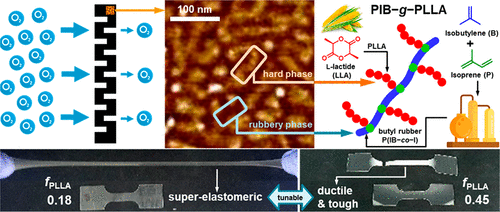当前位置:
X-MOL 学术
›
Macromolecules
›
论文详情
Our official English website, www.x-mol.net, welcomes your feedback! (Note: you will need to create a separate account there.)
Thermoplastic Superelastomers Based on Poly(isobutylene)-graft-Poly(l-lactide) Copolymers: Enhanced Thermal Stability, Tunable Tensile Strength, and Gas Barrier Property
Macromolecules ( IF 5.5 ) Pub Date : 2020-04-01 , DOI: 10.1021/acs.macromol.9b02720 Jeong Suk Yuk 1 , Eunbi Mo 1, 2 , Suhyun Kim 1, 3 , Haemin Jeong 1, 3 , Hyeonji Gwon 1, 4 , Nam-Kyun Kim 1 , Young-Wun Kim 1, 3 , Jihoon Shin 1, 3
Macromolecules ( IF 5.5 ) Pub Date : 2020-04-01 , DOI: 10.1021/acs.macromol.9b02720 Jeong Suk Yuk 1 , Eunbi Mo 1, 2 , Suhyun Kim 1, 3 , Haemin Jeong 1, 3 , Hyeonji Gwon 1, 4 , Nam-Kyun Kim 1 , Young-Wun Kim 1, 3 , Jihoon Shin 1, 3
Affiliation

|
A mechanically adjustable reinforced thermoplastic superelastomer system, with tunable gas-permeability, was developed. The superelastomer is based on a graft copolymer structure, using commercial butyl rubbers (or poly(isobutylene-co-isoprene), P(IB-co-I)) and l- or d,l-lactide (LLA or LA) derived from renewable feedstocks, by a “grafting from” controlled polymerization. First, hydroxyl-functionalized PIB (PIB-g-(OH)) macroinitiators were prepared through epoxidation using an economical alternative to m-chloroperoxybenzoic acid and ring-opening reaction. Second, PIB-based graft copolymers with end-hydroxylated poly(lactide) as hard side-chains, PIB-g-(P(L)LA–OH)s, were synthesized to target fP(L)LA of 0.18–0.45, to achieve mechanical reinforcement and an additional gas barrier. They were subsequently acetylated with an acetic anhydride to produce PIB-g-(P(L)LA–Ac)s with improved thermal stability. The well-defined molecular structures indicated controlled P(L)LA lengths, and the resulting superelastomers demonstrated improved thermal stability with increased Td,5%; microphase-separated structures having spherical and/or elongated features; thermoplastic behaviors proved by TODT, which were much lower than the resulting Td,5%; and superior and adjustable mechanical characterizations, proving to control elastomeric-to-ductile properties. An oxygen permeability value as low as 27 mL mm m–2 day–1 atm–1 was achieved by increasing fP(L)LA to 0.45, comparable to polyethylene terephthalate. The partially biodegradable and processable gas barrier films based on these PIB-g-PLLA thermoplastic superelastomers have great potential for the flexible packaging of food and medical products.
中文翻译:

基于聚(异丁烯)-接枝-聚(l-丙交酯)共聚物的热塑性超级弹性体:增强的热稳定性,可调节的拉伸强度和阻气性
开发了具有可调气体渗透性的机械可调增强热塑性超级弹性体系统。所述superelastomer是基于接枝共聚物的结构,使用商业丁基橡胶(或聚(异丁烯-共-异戊二烯),P(IB- CO -I))和升-或d,升-丙交酯(LLA或LA)衍生自通过“接枝”受控聚合获得可再生原料。首先,羟基官能化PIB(PIB-克- (OH))大分子引发剂是通过环氧化使用经济的替代制备米氯过氧酸和开环反应。其次,以末端羟基化的聚丙交酯为硬侧链的PIB基接枝共聚物g-(P(L)LA-OH)s被合成为目标f P(L)LA为0.18-0.45,以实现机械增强和附加的阻气层。随后将它们用乙酸酐乙酰化,制得具有改善的热稳定性的PIB- g-(P(L)LA-Ac)。明确定义的分子结构表明P(L)LA长度受控制,并且所得的超弹性体表现出改善的热稳定性,且T d,5%增加;具有球形和/或细长特征的微相分离结构;由T ODT证明的热塑性行为远低于所得的T d,5%。; 以及出色且可调节的机械特性,证明可以控制弹性体-延性。通过将f P(L)LA增加到0.45(与聚对苯二甲酸乙二醇酯相当),可实现低至27 mL mm m m –2天–1 atm –1的透氧值。基于这些PIB- g -PLLA热塑性超级弹性体的可部分生物降解和加工的阻气膜在食品和医疗产品的柔性包装方面具有巨大潜力。
更新日期:2020-04-24
中文翻译:

基于聚(异丁烯)-接枝-聚(l-丙交酯)共聚物的热塑性超级弹性体:增强的热稳定性,可调节的拉伸强度和阻气性
开发了具有可调气体渗透性的机械可调增强热塑性超级弹性体系统。所述superelastomer是基于接枝共聚物的结构,使用商业丁基橡胶(或聚(异丁烯-共-异戊二烯),P(IB- CO -I))和升-或d,升-丙交酯(LLA或LA)衍生自通过“接枝”受控聚合获得可再生原料。首先,羟基官能化PIB(PIB-克- (OH))大分子引发剂是通过环氧化使用经济的替代制备米氯过氧酸和开环反应。其次,以末端羟基化的聚丙交酯为硬侧链的PIB基接枝共聚物g-(P(L)LA-OH)s被合成为目标f P(L)LA为0.18-0.45,以实现机械增强和附加的阻气层。随后将它们用乙酸酐乙酰化,制得具有改善的热稳定性的PIB- g-(P(L)LA-Ac)。明确定义的分子结构表明P(L)LA长度受控制,并且所得的超弹性体表现出改善的热稳定性,且T d,5%增加;具有球形和/或细长特征的微相分离结构;由T ODT证明的热塑性行为远低于所得的T d,5%。; 以及出色且可调节的机械特性,证明可以控制弹性体-延性。通过将f P(L)LA增加到0.45(与聚对苯二甲酸乙二醇酯相当),可实现低至27 mL mm m m –2天–1 atm –1的透氧值。基于这些PIB- g -PLLA热塑性超级弹性体的可部分生物降解和加工的阻气膜在食品和医疗产品的柔性包装方面具有巨大潜力。



























 京公网安备 11010802027423号
京公网安备 11010802027423号